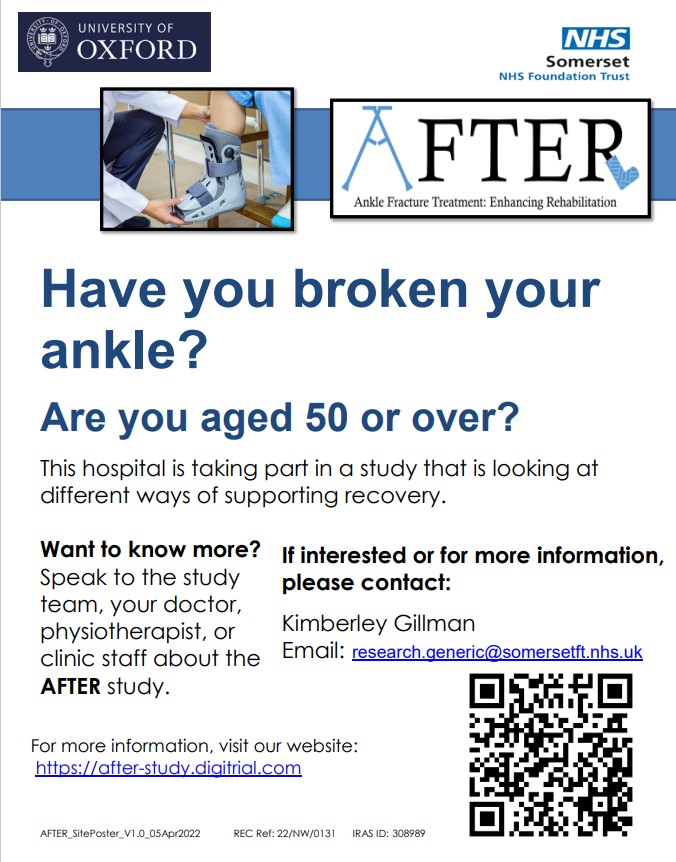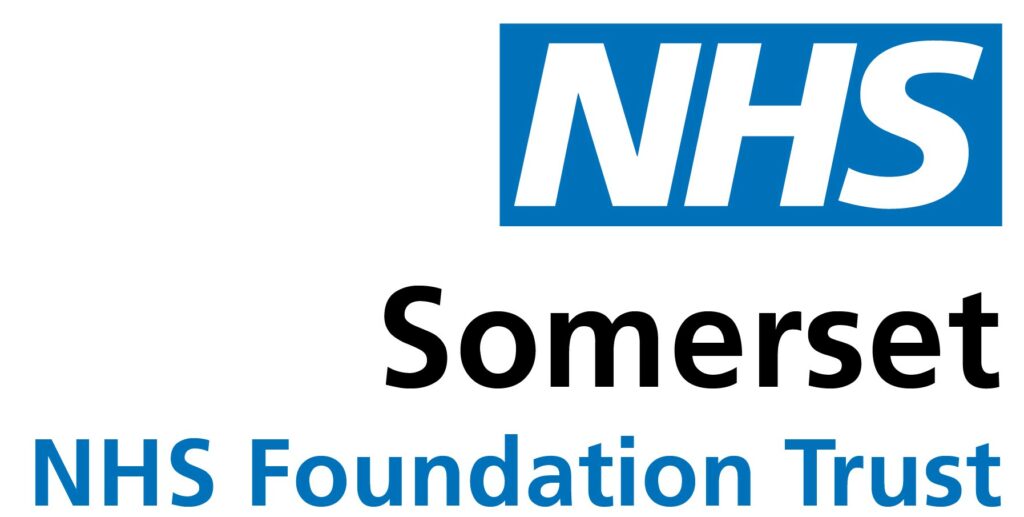Musculoskeletal & Orthopaedics
The following studies are being carried out at the Somerset Foundation Trust.
Musculoskeletal
ACTIVE
External frame versus internal locking plate for articular pilon fracture fixation in adults patients – a multi-centre randomised controlled trial .
A pilon fracture is a severe break of the shin bone where it forms the ankle joint. It is usually caused by high-energy impact such as a fall from a height. These injuries are very difficult to treat and can have a very large negative effect on a person’s quality of life. Surgery is needed to fix the broken bone which can lead to serious infections, meaning more treatment is needed, including on occasion, amputation. Even where the fracture heals well, most patients develop arthritis in the joint. The injury is usually fixed by orthopaedic surgeons from the inside (under the skin) using a plate and screws (called ‘internal fixation’) or fixed from the outside using a ring frame or cage (‘external fixation’). The internal plate is cheaper than the external ring but the internal plate may increase the chance of the patient getting a deep infection. There is genuine uncertainty among surgeons as to which is the preferable surgical option. NICE and Consultant Orthopaedic Surgeons have recommended that high-quality research is needed to find out whether internal or external fixation is best for treating pilon fractures and a better use of NHS money. This study will compare the outcomes of patients who receive internal plate or external fixation at 3, 6, 12 and 24 months follow-up. All adult patients (16 years or older) with a closed type C pilon fracture of the tibia will be included where the treating surgeon believes the patient will benefit from surgical fixation.
The ACTIVE Trial is funded by the National Institute for Health Research Health Technology Assessment programme (reference number: 15/130/84)
Please visit the ACTIVE Trial webpage for more information.
End date for recruitment is 31.10.2023.
FAME – In younger adults with unstable ankle fractures treated with close contact casting, is ankle function not worse than those treated with surgical intervention? The Fractured Ankle Management Evaluation (FAME) Trial.
Every day in the UK around 170 people break an ankle. They often have pain and physical limitations for several weeks, or sometimes months, after the injury.
This trial will assess how using a special, closely moulded, plaster cast instead of an operation affects the outcome of an ankle break in people aged 18-60. It will only include people who would normally have had an operation to treat the ankle break. It is looking at functional outcomes – how well people are and what they can do after a certain recovery time. It will also work out the costs of the different treatments – to the NHS, to the individual, and to wider social care services.
Participants will be randomised to either receive surgery or the plaster cast. After the operation or the plaster cast treatment, all the patients in the study will have the usual additional treatment and follow-up that is currently standard practice at the hospitals.
The researchers will ask patients about their health and abilities and return to work and usual activities, as well as any complications and specific costs. The answers will be collected at the outset, and at 8 weeks, 4 months and 1 year after the injury, and the results from the two groups will be compared.
A few questions will be asked each year for four more years to find out about any longer term effects.
Closed to recruitment.
Please visit the FAME website for more information.
SCIENCE
Surgery or Cast for Injuries of the EpicoNdyle in Children’s Elbows. A multi-centre prospective randomised superiority trial of operative fixation versus non-operative treatment for medial epicondyle fractures of the humerus in children.
The SCIENCE Study is trying to improve the treatment of children who have a broken bone in the elbow called an ‘EpicoNdyle fracture’. About one thousand children sustain this injury in the UK each year. Doctors treat these injuries in different ways. Half of doctors advise to rest the elbow in a cast or splint and allow it to heal by itself, whilst the other half advise surgery to fix the bone. Despite the number of these injuries, doctors are not sure whether one way of treating them is better than the other because it has never been researched.
The only way to compare the treatments fairly is to create two groups of children who are the same, by a process called randomisation. You can’t chose the treatment, and neither can the doctors, otherwise the groups would not be the same. When we have groups of patients who are as identical as possible, we can then compare them fairly in terms of outcomes.
This study will compare the two commonly used treatments in a group of 334 children:
- Resting the arm in plaster cast for up to 4 weeks, to allow it to heal by itself.
- Surgery to fix the bone, usually with a screw and resting the arm in a splint or cast for up to 4 weeks.
All patients will then be followed up in hospital, and get rehabilitation according to the usual practice of the treating hospital, which will include advice about moving the arm, and may include physiotherapy.
Open to recruitment until 30/11/2023
Please visit the SCIENCE website for more information.
CRAFFT
The most common part of the body for a child to break is their wrist. Most need just a plaster cast, but some have surgery to reset the bones before they go in a plaster cast. These operations are really common but doctors are unsure whether they are really necessary in younger children. In younger children up to 10 years old even when the bones break and move totally out of place, there is evidence to suggest that the wrist will heal well and will grow back to a normal shape over a few months. However, families and some doctors worry that if the bones aren’t reset early, then the wrist might not fully return to normal (may still look bent) and it will take a long time to get back to normal activities. On the other hand, there are risks with resetting bones, including that the child will need an anaesthetic or sedation, they may get scars, and may get an infection. Parents and children want to know if surgery is really necessary to reset the bones, or whether a plaster cast with natural healing will be as good. This study is called a trial, which is the best way to compare treatments to get a proper answer. Half the children and young people will have their broken bones treated with surgery, whilst the other half will have a plaster cast with no surgery. Parents and children won’t be able to choose which treatment they get. To make things fair, this will be decided using the technique of randomisation by a computer.
Recruitment end date:30/11/2023
FRUiTi
Every year around 70,000 people in the UK break their hip. Hip fractures are a common and very serious injury in older patients, similar in impact to a major stroke. We will investigate two treatments for one specific type of hip fracture. Currently, surgeons either repair the fracture with screws or remove and replace the broken piece of bone, but we do not know which is better for patients.
We will examine whether either fixing the broken bone or replacing the hip joint gives a better result for people 60 years and over with hip fractures from at least 40 hospitals across the UK. We want to look at how well people feel and how active they are following their fracture. We will also work out the cost of the two treatments – for the individual, for the health service and in terms of social support in the year following the fracture.
A pilot study in a smaller group of hospitals will look closely at our approach to this work – to check that enough people will want to take part in the full study. This will allow us to improve the study processes of the larger study before we get started. All the information from this pilot study will be included in the main study.
To compare the two treatments properly we need 878 people to take part. Over a third of people with a broken hip have memory problems, and as they can struggle to recover from this injury, we plan to include them in this study. If people agree to take part, they will be allocated using a process called randomisation which makes sure that the groups are similar and the comparison between the two treatments is fair. Before and after their operation all the patients will have the usual ward care, rehabilitation and follow up that is standard practice at their hospital.
We will ask patients about their health, pain, walking ability and other daily activities, as well as any complications and specific costs. Their answers will be collected at the outset, and at 6 weeks, 4 months and 1 year after confirmed diagnosis of their hip fracture, and the results from the two groups compared. A few questions will be asked each year for five years to find out about any longer-term effects. We will also ask people for their permission to use de-identified information, which means that it is unlikely that we can identify them from the records received, from national databases that are already being routinely collected.
ROSA
We are looking to recruit participants in to a post market clinical follow-up (PMCF) study of the Ceramisys ReproBone ® product range. The objective of the study is to compile real world clinical data on safety and performance of the Ceramisys ReproBone® synthetic bone graft in a commercial clinical setting. Synthetic means the bone graft has been especially made to imitate the natural bone in a graft substitute.
The study will be conducted at a minimum of 6 UK/EU sites by surgeons who are experienced in or familiar with and skilled in the techniques of bone repair and replacement. A total of 220 subjects will receive the study treatment.
Patients included in this study will include males and females 18 – 80 years of age who require bone grafting in the spine, long bone or extremities resulting from traumatically or surgically created defects.
Each patient will be followed for a period of one year after enrolment according to the schedule and standard practice at the enrolling centres. There will be no additional visits, nor procedures for subjects who participate in the study. Subjects are expected to be followed at implant, then at 3 months post implant visit, and then at 6 months and through 1 year post implant. An intermediate visit may be scheduled in a number of patients, per physician discretion. Follow-ups should not involve subjecting the patient to additional risks or burdens, therefore whilst x-rays/MRI evidence is required at the prescribed follow-ups, the patient should not be subjected to evaluations above and beyond those normally considered by the evaluating surgeon unless ethical approval for this is obtained.
Primary endpoints will be successful radiographic bone repair. Secondary Endpoints will include improvement in pain/function and measurement of absorption into the bodies circulation cells or tissue (material resorption), and where applicable loss of correction.
Please contact Kimberley Gillman on 01823 343635 for any further information or questions. The above contact can also provide you with the Patient Information Sheet should you be a potential participant for this study.
Bracing Adolescent Idiopathic Scoliosis – The BASIS Study
A £2.5m research study is now open in the UK, looking at the effectiveness of a night-time brace in the treatment of adolescent idiopathic scoliosis. Led by Sheffield Children’s Hospital, the Bracing Adolescent Idiopathic Scoliosis (BASIS) study is currently accepting patients from 15 NHS Trusts across the UK, with another 5 Trusts in set up, hoping to join in the very near future.
The ‘full-time’ brace is the current back brace offered within the NHS, and this is usually prescribed to be worn for 20 hours a day. Although in many patients, it stops the curve reaching a size where surgery would be considered, the brace needs to be worn until growth has finished which is usually several years. It is recognised that this is a very difficult treatment for many young people. The alternative offered as part of the BASIS study, is a new ‘night-time’ brace, which is worn for around 9 hours whilst in bed at night. As this brace works whilst the patient is lying down, it can provide a stronger force to push the curve straighter.
The night-time brace may sound like a more attractive option for patients, but there is currently less evidence to support it’s effectiveness. And this is why the BASIS study is taking place!
At the moment, there are 54 patients taking part in BASIS, and roughly half are receiving full time brace treatment, with the other half receiving the night time brace. The study is aiming to involve 780 patients over the next 3 years, and all patients taking part will be followed up in the study until 2 years after they stop brace treatment.
If you’d like to know more about the study, you can visit the BASIS website for further information, and contact details for the coordinating team.

This study is funded by the NIHR Health Technology Assessment (HTA) programme (NIHR131081). The views expressed are those of the author(s) and not necessarily those of the NIHR or the Department of Health and Social Care.
End recruitment: 28/02/2025
AFTER Study


